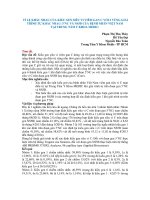THUỐC TƯƠNG PHẢN CTMRI: ỨNG DỤNG THỰC TẾ TẠI MEDIC
Bạn đang xem bản rút gọn của tài liệu. Xem và tải ngay bản đầy đủ của tài liệu tại đây (2.24 MB, 16 trang )
MEDIC
THUỐC TƯƠNG PHẢN CT-MRI:
ỨNG DỤNG THỰC TẾ TẠI MEDIC
BS CHÂU NGỌC MINH PHƯƠNG
BS NGUYỄN THÀNH ĐĂNG
Các thuốc tương phản tại MEDIC
MEDIC
CT
MRI
Non ionic
Ionic
Non ionic
Ultravist
Xenetix
Omnipaque
Dotarem
Primovist
Gadovist
Những vấn đề chưa thống nhất
MEDIC
1. Xét nghiệm chức năng thận trước khi tiêm thuốc tương phản?
2. Độ lọc cầu thận bao nhiêu thì khơng được tiêm thuốc tương phản?
3. Tiêm thuốc tương phản ở phụ nữ có thai? Đang cho con bú?
4. Sau khi tiêm chất cản quang thì bao lâu tiêm được chất cản từ?
Bệnh nhân chụp CT và MRI có tiêm thuốc tương phản: chụp CT hay
MRI trước?
5. Sau khi tiêm thuốc tương phản thì cần theo dõi bệnh nhân trong bao
lâu?
Khuyến cáo
MEDIC
March 2018
Henrik S. Thomsen, Chairman
MEDIC
1. Xét nghiệm chức năng thận trước khi
tiêm thuốc cản quang?
MEDIC
1. Xét nghiệm chức năng thận trước khi
tiêm thuốc cản quang?
MEDIC
1. Xét nghiệm chức năng thận trước khi
tiêm thuốc cản quang?
MEDIC
1. Xét nghiệm chức năng thận trước khi
tiêm thuốc tương phản từ?
ESUR (2018)
ACR (2023)
The risk of Post Contrast – Acute
Kidney Injury is very low when
gadolinium-based contrast agents
are used in approved doses.
Gadolinium-based contrast media are not
considered nephrotoxic at dosages
approved for MR imaging.
Increased risk of Nephrogenic Systemic Fibrosis (NSF) when certain
gadolinium-based contrast agents used in patients with kidney dysfunction.
- Lowest risk: Gadovist, Dotarem
- Intermediate risk: Primovist
Laboratory testing of renal
function is not mandatory.
- Group II (agents with few cases of NSF
reported): Gadovist, Dotarem
Assessment of renal function is
optional prior to IV administration.
- Group III (agents for which data remains
limited): Primovist
Renal function should be tested (within
2 days) in high risk patients: history of
renal diseases and/or diabetes mellitus.
MEDIC
2. Ngưỡng độ lọc cầu thận an toàn cho
thuốc cản quang?
Statements from ACR and the National Kidney Foundation (2020)
The risk of CI-AKI from intravenous iodinated contrast media is lower than previously
thought. Necessary contrast material–enhanced CT without a suitable alternative
should not be avoided solely on the basis of CI-AKI risk.
CI-AKI risk should be determined primarily by using CKD stage and AKI. Patients at
high risk include those with recent AKI and those with eGFR less than 30
mL/min/1.73 m2, including nonanuric patients undergoing maintenance dialysis.
Prophylaxis with intravenous normal saline is indicated for patients not undergoing
dialysis who have eGFR less than 30 mL/min/1.73 m2 or AKI. In individual high-risk
circumstances, prophylaxis may be considered in patients with eGFR of 30–44
mL/min/1.73 m2 at the discretion of the ordering clinician.
Kidney replacement therapy should not be initiated or have the schedule adjusted
solely on the basis of contrast media administration.
In patients at high risk of CI-AKI, ad hoc lowering of contrast media dose below a
known diagnostic threshold should be avoided. Rather, the minimum routine clinical
diagnostic dose should be used.
Renal impairment is NOT an absolute contraindication for contrast media
MEDIC
2. Ngưỡng độ lọc cầu thận an toàn cho
thuốc tương phản từ?
ESUR (2018)
ACR (2023)
Never deny a patient a clinically
well-indicated enhanced MRexamination.
Group II gadolinium-based agents
are strongly preferred in patients at risk
for NSF (eGFR < 30 ml/min or AKI).
Gadolinium agents should be used
with caution in patients with GFR <
30ml/min.
In an anuric patient with no residual
renal function, it would be reasonable
to consider iodinated contrast media
and CT rather than MRI, assuming the
anticipated diagnostic yield is similar.
In all patients use the smallest
amount of contrast medium
necessary for a diagnostic result.
In patient already on dialysis, if feasible,
elective GBCA-enhanced MRI be
performed before regularly schedule
dialysis.
MEDIC
MEDIC
MEDIC
5. Theo dõi sau tiêm
MEDIC
Kết luận
MEDIC
1. Xét nghiệm chức năng thận trước khi tiêm:
- Thuốc tương phản từ: khơng bắt buộc với nhóm thuốc Gadovist,
Dotarem.
- Thuốc cản quang và thuốc tương phản từ Primovist: trên bệnh
nhân có nguy cơ cao bao gồm tiền căn bệnh thận, phẫu thuật thận,
đái tháo đường ± metformin, đạm niệu (+), tăng axit uric máu, tăng
huyết áp.
2. Độ lọc cầu thận an toàn là ≥ 30 ml/ph/1,73m2. Tuy nhiên, eGFR <
30 ml/ph/1,73m2 không phải là CCĐ tuyệt đối của thuốc tương phản.
3. Tiêm thuốc tương phản trên phụ nữ có thai trong trường hợp hết
sức cần thiết.
4. Bệnh nhân có chức năng thận bình thường có thể tiêm hai liều
thuốc tương phản cách nhau ≥ 4 giờ.
5. Theo dõi bệnh nhân ít nhất 30 phút sau tiêm tương phản.
MEDIC
CẢM ƠN QUÝ ĐỒNG NGHIỆP









